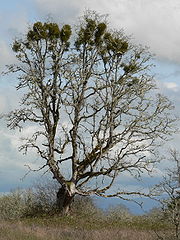
William L. Finley National Wildlife Refuge
Encyclopedia
William L. Finley National Wildlife Refuge is a natural area in the Willamette Valley
in Oregon
, United States
. It was created to provide wintering habitat for Dusky Canada Geese. Unlike other Canada Geese, Dusky Canada Geese have limited summer and winter ranges. They nest on Alaska
's Copper River
Delta and winter almost exclusively in the Willamette Valley. Habitat loss, predation, and hunting have caused a decrease in population.
Located ten miles south of Corvallis, Oregon
, the refuge protects many of the historic habitats of the valley, including the largest remaining tract of native Willamette Valley wet prairie. Fields of wildlife food crops are interspersed with Oregon white oak savannah, meandering creeks with bottomland Oregon Ash
forest, old growth Bigleaf Maple
, and native prairie.
 Other management goals are to preserve native species and enhance biodiversity including the rare oak savannah, upland prairie, and wet prairie habitats. Endangered and threatened species such as Peregrine Falcon
Other management goals are to preserve native species and enhance biodiversity including the rare oak savannah, upland prairie, and wet prairie habitats. Endangered and threatened species such as Peregrine Falcon
s, Bald Eagle
s, Oregon Chub, and Bradshaw's Desert Parsley find protection and sanctuary on the refuge. A herd of Roosevelt Elk
can be found in the bottomland forests or farm fields on the refuge.
Under cooperative agreements, area farmers plant refuge fields to produce nutritious grasses preferred by geese. The geese also need water for resting and foraging habitat. Many refuge wetlands occur naturally; others are created by dikes and levees. Some refuge wetlands, drained or channelized by previous owners, are being restored in low-lying areas of the refuge to increase diversity and desirability of habitat for wildlife.
The majority of wetlands are being managed as moist soil units, to promote growth of wetland food plants (millet, smartweed, sedges, etc.) used as food by waterfowl and other wildlife. By resting in undisturbed areas on the refuges, wintering geese regain energy reserves required for migration and nesting. This sanctuary reduces depredation problems on neighboring private lands.
Of historic interest is the Fiechter House, completed in 1857, and thought to be the oldest house in Benton County. The refuge was named for William L. Finley
, an early conservationist who persuaded President Theodore Roosevelt
to set aside the first National Wildlife Refuge
west of the Mississippi River
.
Two county roads passing through the refuge are open to the public throughout the year. Similar access is also provided at four viewpoints (kiosks and bulletin boards) and two trails (Woodpecker Loop and Mill Hill). To provide a quiet resting area, waterfowl habitat is closed to public entry while the geese are in residence, from November 1 through April 30. This winter waterfowl closure includes all portions of the refuge except the two trails, kiosks, bulletin boards, and headquarters building.
Willamette Valley
The Willamette Valley is the most populated region in the state of Oregon of the United States. Located in the state's northwest, the region is surrounded by tall mountain ranges to the east, west and south and the valley's floor is broad, flat and fertile because of Ice Age conditions...
in Oregon
Oregon
Oregon is a state in the Pacific Northwest region of the United States. It is located on the Pacific coast, with Washington to the north, California to the south, Nevada on the southeast and Idaho to the east. The Columbia and Snake rivers delineate much of Oregon's northern and eastern...
, United States
United States
The United States of America is a federal constitutional republic comprising fifty states and a federal district...
. It was created to provide wintering habitat for Dusky Canada Geese. Unlike other Canada Geese, Dusky Canada Geese have limited summer and winter ranges. They nest on Alaska
Alaska
Alaska is the largest state in the United States by area. It is situated in the northwest extremity of the North American continent, with Canada to the east, the Arctic Ocean to the north, and the Pacific Ocean to the west and south, with Russia further west across the Bering Strait...
's Copper River
Copper River (Alaska)
The Copper River or Ahtna River is a 300-mile river in south-central Alaska in the United States. It drains a large region of the Wrangell Mountains and Chugach Mountains into the Gulf of Alaska...
Delta and winter almost exclusively in the Willamette Valley. Habitat loss, predation, and hunting have caused a decrease in population.
Located ten miles south of Corvallis, Oregon
Corvallis, Oregon
Corvallis is a city located in central western Oregon, United States. It is the county seat of Benton County and the principal city of the Corvallis, Oregon Metropolitan Statistical Area, which encompasses all of Benton County. As of the 2010 United States Census, the population was 54,462....
, the refuge protects many of the historic habitats of the valley, including the largest remaining tract of native Willamette Valley wet prairie. Fields of wildlife food crops are interspersed with Oregon white oak savannah, meandering creeks with bottomland Oregon Ash
Oregon Ash
Fraxinus latifolia is a member of the ash genus Fraxinus, native to western North America.-Distribution:Fraxinus latifolia is found: on the west side of the Cascade Range from southwestern British Columbia south through western Washington, western Oregon, and northwestern California; and in...
forest, old growth Bigleaf Maple
Bigleaf Maple
Acer macrophyllum is a large deciduous tree in the genus Acer.It can grow to be up to 35 m tall, but more commonly grows 15 m to 20 m tall. It is native to western North America, mostly near the Pacific coast, from southernmost Alaska to southern California...
, and native prairie.

Peregrine Falcon
The Peregrine Falcon , also known as the Peregrine, and historically as the Duck Hawk in North America, is a widespread bird of prey in the family Falconidae. A large, crow-sized falcon, it has a blue-gray back, barred white underparts, and a black head and "moustache"...
s, Bald Eagle
Bald Eagle
The Bald Eagle is a bird of prey found in North America. It is the national bird and symbol of the United States of America. This sea eagle has two known sub-species and forms a species pair with the White-tailed Eagle...
s, Oregon Chub, and Bradshaw's Desert Parsley find protection and sanctuary on the refuge. A herd of Roosevelt Elk
Elk
The Elk is the large deer, also called Cervus canadensis or wapiti, of North America and eastern Asia.Elk may also refer to:Other antlered mammals:...
can be found in the bottomland forests or farm fields on the refuge.
Under cooperative agreements, area farmers plant refuge fields to produce nutritious grasses preferred by geese. The geese also need water for resting and foraging habitat. Many refuge wetlands occur naturally; others are created by dikes and levees. Some refuge wetlands, drained or channelized by previous owners, are being restored in low-lying areas of the refuge to increase diversity and desirability of habitat for wildlife.
The majority of wetlands are being managed as moist soil units, to promote growth of wetland food plants (millet, smartweed, sedges, etc.) used as food by waterfowl and other wildlife. By resting in undisturbed areas on the refuges, wintering geese regain energy reserves required for migration and nesting. This sanctuary reduces depredation problems on neighboring private lands.
Of historic interest is the Fiechter House, completed in 1857, and thought to be the oldest house in Benton County. The refuge was named for William L. Finley
William L. Finley
William Lovell Finley was an American wildlife photographer and conservationist from Southern California. The William L. Finley National Wildlife Refuge was named in his honor.-Family:...
, an early conservationist who persuaded President Theodore Roosevelt
Theodore Roosevelt
Theodore "Teddy" Roosevelt was the 26th President of the United States . He is noted for his exuberant personality, range of interests and achievements, and his leadership of the Progressive Movement, as well as his "cowboy" persona and robust masculinity...
to set aside the first National Wildlife Refuge
National Wildlife Refuge
National Wildlife Refuge is a designation for certain protected areas of the United States managed by the United States Fish and Wildlife Service. The National Wildlife Refuge System is the world's premiere system of public lands and waters set aside to conserve America's fish, wildlife and plants...
west of the Mississippi River
Mississippi River
The Mississippi River is the largest river system in North America. Flowing entirely in the United States, this river rises in western Minnesota and meanders slowly southwards for to the Mississippi River Delta at the Gulf of Mexico. With its many tributaries, the Mississippi's watershed drains...
.
Two county roads passing through the refuge are open to the public throughout the year. Similar access is also provided at four viewpoints (kiosks and bulletin boards) and two trails (Woodpecker Loop and Mill Hill). To provide a quiet resting area, waterfowl habitat is closed to public entry while the geese are in residence, from November 1 through April 30. This winter waterfowl closure includes all portions of the refuge except the two trails, kiosks, bulletin boards, and headquarters building.

